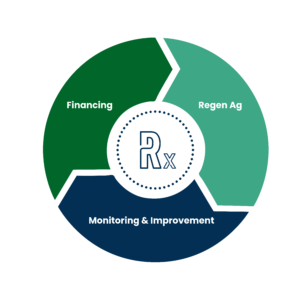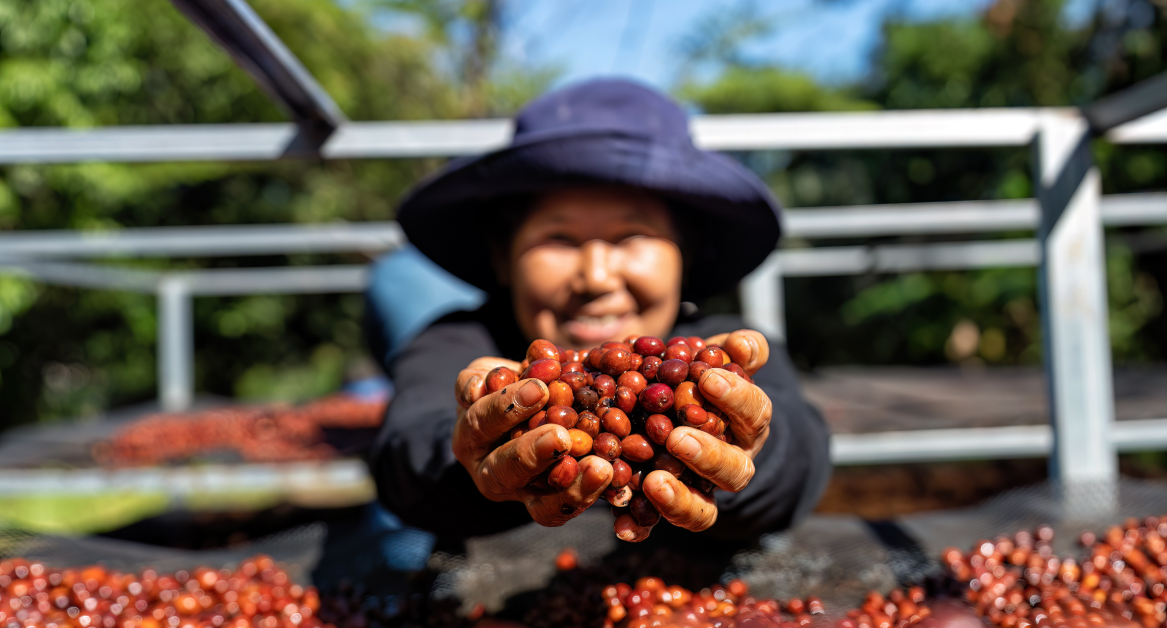As we stand on the brink of environmental uncertainty, regenerative agriculture practices are becoming a key part of conversations about sustainable growth. Regenerative agriculture is a transformative approach that aligns human agriculture with nature, aiming not just to sustain but to enrich and heal the earth for future generations. It goes beyond sustaining—it rejuvenates, enhances, and heals.
Food production is no longer just about the quantity, but the quality and longevity of the farming methods employed. The idea is simple yet revolutionary:
Nurture the earth, and it will nourish us. 🌏
It’s a principle that RegenX has embedded at the core of its mission, paving the easier way for food buyers and regenerative farmers to join hands and create a future where agriculture and ecology can thrive together.
History and evolution of regenerative agriculture
The beginnings of regenerative agriculture
Regenerative agriculture emerged as a blend of traditional knowledge and contemporary science, reacting to urgent concerns of soil erosion and ecological decline. As industrial agriculture increased, its reliance on monocultures and chemicals has significantly strained soil health. In the early days, regenerative farming practices were the whispers of outlier farmers and ranchers who recognized the land’s distress signals.
However, the term and its modern movement began to take shape in reaction to the post-World War II industrial agriculture boom.
- Pre-20th Century: Indigenous people around the world practiced forms of regenerative agriculture, although it wasn’t labeled as such. These practices included crop diversity, polycultures, and agroforestry.
- 1940s – 1960s: The Green Revolution marked a surge in agricultural productivity with the introduction of synthetic fertilizers, pesticides, and high-yield crop varieties. However, by the 1970s, the drawbacks became apparent as ecological degradation intensified.
The Green Revolution’s dusk and a regenerative dawn
The industrial approach to agriculture, powered by the Green Revolution, brought about remarkable spikes in productivity by introducing synthetic fertilizers, pesticides, and high-yield crop varieties. However, this approach has also led to unintended consequences such as soil degradation, reduced biodiversity, and increased carbon emissions.
Therefore, a long-term and more promising approach arrived. From the 70s to the 80s, the term “regenerative agriculture” began to gain traction among alternative farming communities. Pioneers like Robert Rodale of the Rodale Institute promoted the concept as a more sustainable form of agriculture focusing on soil health. In contrast to industrial farming, which often focuses on short-term yields, regenerative agriculture invites us to take a long-term perspective.
Where conventional methods may strip the soil of its nutrients and structure, regenerative farming practices emphasize soil organic matter enhancement, nutrient cycling, and biodiversity as the cornerstones of food production. It’s a system that sees carbon dioxide not merely as a greenhouse gas but as a building block for soil fertility when properly managed.
Modern movements: Regenerative agriculture takes root
With multiple Regen Ag initiatives and studies executed globally, regenerative agriculture is now in the spotlight as a leading solution for several of the world’s most pressing issues.
According to the Rodale Institute’s research, regenerative agriculture practices could sequester more than 52 gigatonnes of carbon dioxide equivalent (CO2) globally per year, effectively offsetting up to 100% of current annual CO2 emissions. Studies also suggest that adopting regenerative practices can increase soil organic matter by up to 8-15% within five years, enhancing soil fertility and crop resilience.

From reversing climate effects by sequestering carbon dioxide to restoring degraded soil through biodiverse farming practices, the movement addresses both ecological and economic challenges. It builds resilience against climate instability while promising a more equitable economic landscape for farmers and ranchers worldwide.
7 core principles of regenerative agriculture
Regenerative agriculture takes root with 7 principles that aim to restore and enhance natural systems.
Building soil health
Healthy soil is the bedrock of regenerative agriculture. Soil organic matter is pivotal in this principle, serving as a reservoir of nutrients, a facilitator of water absorption, and a buffer against pests and diseases. Key practices for building soil health include:
- Cover cropping: Growing cover crops like clover or rye in the off-season protects the soil from erosion, suppresses weeds, and enhances soil fertility.
- Reduced tillage: Minimizing the disruption of soil maintains its structure, preserves microbial habitats, and reduces carbon dioxide emissions.
Enhancing biodiversity
Biodiversity is crucial for resilient ecosystems. Diverse plant and animal species contribute to the robustness of farming systems by supporting nutrient cycling, pollination, and pest management. Practices to enhance biodiversity are:
- Intercropping: Planting various crops in close proximity supports a diversity of insects and soil organisms, promoting a balanced ecosystem.
- Agroforestry: Incorporating trees into agricultural landscapes offers habitat for wildlife, contributes to carbon sequestration, and can provide additional income through timber or fruit.
Integrating livestock
Animals play a vital role in regenerative agriculture. Their movements and behaviors can naturally till the soil, distribute seeds, and cycle nutrients. Effective integration of livestock into farming practices includes:
- Rotational grazing: Moving livestock regularly mimics natural grazing patterns, improves pasture health, and reduces the chance of overgrazing.
- Multi-species grazing: Grazing different types of animals on the same land can optimize the use of pasture and minimize pests and diseases.
Conserving water
Water conservation and management are imperative in the era of climate change. Regenerative practices aim to enhance the water cycle by improving soil structure and water retention. Actions include:
- Swales and rain gardens: These landscape features capture rainwater, allowing it to soak into the ground and recharge aquifers instead of running off.
- Drip irrigation: This efficient irrigation method delivers water directly to plant roots, reducing evaporation and conserving water resources.
Promoting carbon sequestration
Carbon sequestration is a process by which atmospheric carbon dioxide is taken up by plants through photosynthesis and stored as carbon in biomass and soils. Regenerative practices such as cover cropping, agroforestry, and managed grazing all contribute to sequestering carbon, turning agriculture into a potential carbon sink rather than a source.
Supporting farmer livelihoods
Regenerative agriculture is not only about environmental stewardship but also about ensuring the economic viability of farmers and ranchers. By transitioning to regenerative practices, they can reduce input costs, improve the resilience of their land against climate extremes, and often receive premium prices for their products.
Long-term mindset
Regenerative agriculture requires a long-term commitment. It is an investment in the future health of the planet and the prosperity of communities that rely on the land. This principle encourages patience and foresight, recognizing that the benefits of regenerative practices accumulate over time.
In our next segment, we will explore the tangible benefits of regenerative agriculture and how it transcends the boundaries of farms to influence global ecosystems and economies.
The benefits of regenerative agriculture
The approach taken by regenerative agriculture can have a ripple effect, influencing everything from our immediate environment to global climate patterns.
Ecological restoration
- Carbon sequestration: Enhanced through techniques like cover crops and reduced tillage, this process traps atmospheric carbon in the soil, mitigating climate change.
- Biodiversity: Regenerative practices create habitats for various species, promoting a balanced ecosystem.
- Soil health: Healthy soil leads to healthier crops, reducing the need for chemical inputs and fostering resilience to pests and diseases.
- Water management: Improved soil structure allows for better water retention and reduces runoff, protecting water sources.
Economic viability
- Farm productivity: Over time, regenerative practices can lead to increased yields as soils become more fertile and less input-reliant.
- Cost reduction: By minimizing the need for expensive fertilizers and pesticides, farmers can cut costs significantly.
- Premium market access: RegenX facilitates direct access to buyers willing to pay more for sustainably produced ingredients.
Social benefits
- Farmer well-being: Farmers engaged in regenerative practices often experience a stronger connection to their land and a sense of stewardship.
- Community health: Local communities benefit from access to cleaner water and air, and food that’s free from harmful chemicals.
Food security
- Resilience to climate change: With healthier soils and ecosystems, regenerative agriculture creates more resilient food systems capable of withstanding extreme weather events.
- Nutrient-dense foods: There’s an emerging understanding that the quality of the food we eat is directly related to the health of the soils it grows in. Regeneratively farmed produce is often richer in nutrients and devoid of harmful chemicals, acting as a form of preventive medicine.
Tackling the challenges of regenerative agriculture
Transitioning to regenerative agriculture isn’t a walk in the park. It comes with its own set of challenges that must be acknowledged and addressed to realize its full potential.
Access to knowledge and resources
- Transitioning to regenerative practices often requires a knowledge base and skill set that many farmers may not possess initially. This challenge is compounded by limited access to resources that facilitate such a transition.
- Solutions: Comprehensive training programs, extension services, and mentorship initiatives can provide farmers with the knowledge and skills required. Access to resources can be improved through partnerships, grants, and subsidies that support sustainable farming practices.
Economic viability
- The upfront cost of transitioning to regenerative farming can be a deterrent, especially for smallholder farmers. The return on investment may also not be immediately apparent, creating financial strain.
- Solutions: Financial incentives, such as payment for ecosystem services, can help offset initial costs. Additionally, creating markets for regeneratively grown products assures farmers of a stable demand.
Scaling up
- Regenerative agriculture needs to be practiced on a large scale to make a significant impact. However, scaling up individual operations can be daunting due to the variability of natural systems and the bespoke nature of regenerative practices.
- Solutions: Technology plays a pivotal role in scaling up by enabling precision agriculture, data-driven decision-making, and efficient resource management. Networks and cooperatives can also support scaling by pooling resources and knowledge.
Policy and market dynamics
- Current agricultural policies and market dynamics often favor conventional farming practices, leaving regenerative agriculture at a competitive disadvantage.
- Solutions: Advocacy for policy change is crucial. Aligning regenerative agriculture with economic incentives can shift market dynamics to support sustainable practices. Sustainable procurement policies by large buyers can create significant demand for regeneratively produced goods.
Measuring success
- Assessing the impact of regenerative practices can be complex due to the multitude of variables in ecological systems and the long-term nature of the benefits.
- Solutions: Developing robust, yet flexible, metrics and monitoring systems that can account for the complexity of ecosystems is essential. Such systems should be standardized to allow for comparison and improvement.
In essence, while regenerative agriculture presents a beacon of hope for a more sustainable future, it demands concerted efforts across the spectrum.
Be a part of the regenerative agriculture solution!
Whether you’re an eco-investor looking for a world-beneficial investment, a farmer looking to transition to regenerative practices, a food producer seeking sustainable ingredients, or a consumer who cares about the sustainability of our world, RegenX is your partner in this journey.
At the heart of the regenerative agriculture revolution, RegenX stands as a key facilitator, connecting regenerative farmers with global food buyers. Our RegenX Flywheel model ensures a win-win: farmers get fair prices and buyers access premium, sustainable ingredients.
Embrace the RegenX solution:

- Financial innovation: RegenX provides pre-harvest financing to farmers adopting regenerative practices, lowering their cost of financing and increasing farm-gate prices.
- Post-harvest support & monitoring: Elevating farming withexpert guidance.
- Traceability & transparency: Clear sourcing for buyer confidence.
- Climate action: Committing to significant CO2e sequestration.
Contact us to begin your regenerative journey 🌱



